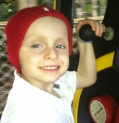 Figure legend: Shown is a chicken egg after using the Egg Topper. The membrane that lies under the shell is where we place fluorescent tumor cells to test their ability to move through blood and lymphatic vessels into the developing chick. Our hope is to find a number of drugs that slow or reverse the process of tumor cells metastasizing from one location to the next.
Figure legend: Shown is a chicken egg after using the Egg Topper. The membrane that lies under the shell is where we place fluorescent tumor cells to test their ability to move through blood and lymphatic vessels into the developing chick. Our hope is to find a number of drugs that slow or reverse the process of tumor cells metastasizing from one location to the next.In 2008 we had an idea: we should try to identify drug treatments that help prevent the spread of tumor cells throughout the body, or at a minimum treat the cancer if it does spread. How could we go about doing this?
Tumor cells moving from one place in the body to another is a multi-step process. First, the tumor cell unattaches from its original location, Next it moves into a blood vessel or lymphatic channel and moves about the body. Finally the tumor cell exits the blood vessel and comes to rest at its final destination somewhere else in the body. Research of this complex process requires more than test tubes or petri dishes: for better or worse, this type of research needs to involve preclinical models (traditional research might use mice).
In 1962, Sidney Farber was investigating whether metastatic tumor cells from childhood cancer patients could move from the membrane under the shell of ordinary chicken eggs into the developing chick within the egg. This was a promising idea, as fertilized chicken eggs were inexpensive, and the assay (examination) takes only 12 days to complete. With over 45 years having passed since Farber’s investigation, and few pharmaceutical companies adopting this method to test anti-metastasis drugs, it seemed that many hurdles may lay ahead. This may have seemed like a high risk endeavor, but one that we believed in, and was embraced by Alex’s Lemonade Stand Foundation through an Innovation Award.
To date, we have overcome most technical hurdles of the assay by adapting modern genetic tools, new biomaterials for encapsulating of tumor cells, and new advances in imaging technology. We’ve also begun testing some novel new therapeutic agents. Of them, we are most intrigued by the effects of drugs that inhibit the metabolism of fast-twitch (anaerobic) muscle, which seems to have a particularly strong effect on the less curable form of the childhood muscle cancer, rhabdomyosarcoma.
So where do we go from here? The traditional answer might be we select the promising agents from the egg screening tests, write NIH grants to propose testing these drugs on other preclinical models (the grant review process can take more than a year from start to finish), and then see whether it is reasonable or feasible to move these drugs to clinical trials. Yet there are also surprising opportunities, too, made possible by ALSF – who is arranging introductions to pharmaceutical companies to accelerate the testing of new drugs for childhood cancer. ALSF is an exciting catalyst for innovation and new paradigms. Through the efforts of a group like ALSF, change can be tangible.
For more information about our research, please visit our blog at http://kellerlabblog.blogspot.com/ .
Sincerely,
Charles Keller, MD
Greehey Children’s Cancer Research Institute
March 26, 2009

